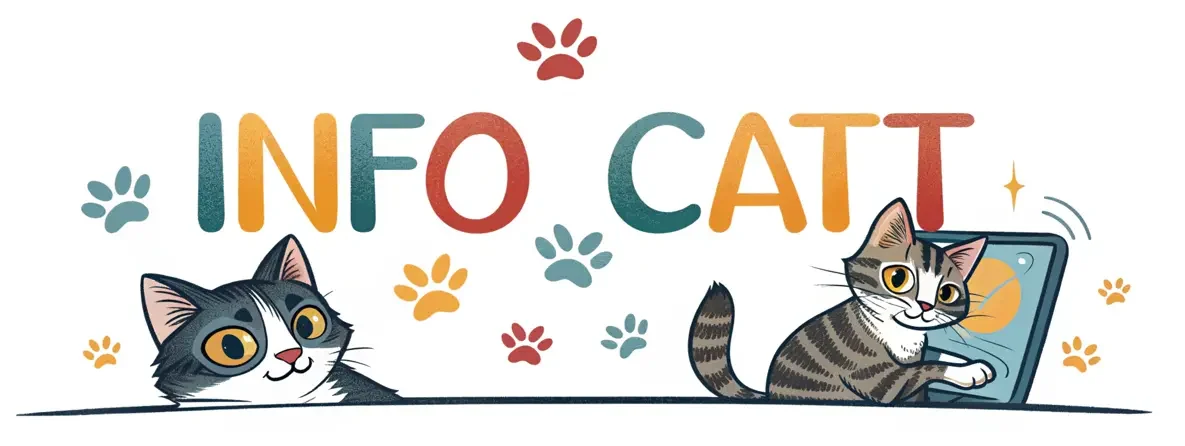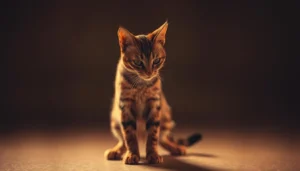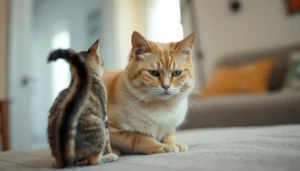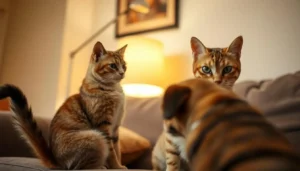Every cat owner knows that cats have a complex emotional world. Understanding if a cat is jealous can change your bond with them. Cats may seem independent, but they feel deep emotions that surprise their families.
Spotting a jealous cat isn’t just about stopping bad behavior. It’s about building a closer bond with your pet. When cats feel left out or threatened, they show it in subtle ways. These changes can surprise you.
Introducing a new pet, welcoming a baby, or changing your home can upset your cat. Knowing how to read your cat’s emotional signals is key. These signs of jealousy are real and need understanding and care.
Understanding Cat Jealousy and Its Root Causes
Cats have complex emotions that often surprise their owners. To understand cat jealousy, we must explore their psychological world. Cats feel jealousy, competition, and the need to protect their territory, just like humans.
Experts say cats form strong bonds with their environment and people. When their sense of security is threatened, they show jealousy. This is how they communicate their feelings.
The Psychology Behind Feline Emotions
Cats don’t just react randomly when they feel jealous. Their jealousy comes from survival instincts. They behave in certain ways to:
- Protect their territory
- Keep social hierarchies
- Ensure they get the resources they need
“Cats communicate through subtle behavioral cues that reveal their complex emotional landscape.” – Dr. Sarah Menzies, Feline Behavioral Specialist
Common Triggers of Jealous Behavior
Several situations can make cats jealous. Knowing these triggers helps owners manage their pet’s feelings. Some common causes include:
- Introducing new pets
- Changes in family dynamics
- Shifts in daily routines
- Less personal attention
Evolution of Territorial Instincts
Your cat’s jealous reactions come from their wild ancestors. Wild cats needed to protect their territory to survive. Domestic cats still have this instinct to protect their space and relationships. It’s a survival strategy passed down through generations.
Physical Signs That Your Cat Is Feeling Jealous
It can be hard to tell if your cat is jealous. But their body language is very telling. Cats show their feelings in special ways, like when they feel left out or threatened.
Look out for these signs of jealousy in your cat:
- Tail Positioning: A swishing or puffed-up tail means they’re feeling strong emotions
- Ears that are flat against their head can mean they’re ready to fight
- Fur that stands up or bristles shows they’re upset
- They might hiss or growl more than usual
Jealous cats often act out in direct ways. They might stand between you and others, trying to keep you to themselves.
Some cats show jealousy in more subtle ways. They might:
- Stand up straight when another pet comes near
- Sit on your things or personal items
- Look tense when they see someone they don’t like
Knowing these signs helps you meet your cat’s emotional needs. This way, jealousy won’t turn into bigger problems.
How Can You Tell If A Cat Is Jealous: Key Behavioral Changes
Cats show their feelings in complex ways that humans might miss. Knowing these signs helps you see when your cat is jealous or stressed about its territory.
Spotting jealousy in cats needs careful watching of their unique ways of talking. Their behavior shows how much they care about their territory.
Aggressive Body Language
Jealous cats show their feelings through their body language. Look out for these signs:
- Tail swishing rapidly back and forth
- Ears flattened against the head
- Arched back with fur standing on end
- Hissing or growling when another pet approaches
Changes in Social Interaction
Jealous cats change how they act around others. They might become very clingy, wanting more attention from you. They also might sit between you and others they don’t like.
- Constant meowing or loud vocalization
- Blocking pathways or sitting on your lap unexpectedly
- Interrupting interactions with other pets or family members
Territorial Marking Behaviors
When cats feel their space is being taken, they mark it more. They do this in different ways:
- Spraying urine on furniture or walls
- Scratching surfaces more frequently
- Rubbing their scent on objects to claim ownership
Understanding these emotional changes in cats helps create a more harmonious home environment for both you and your feline companion.
The Impact of New Pets on Your Cat’s Behavior
Bringing a new pet home can make your cat very jealous. Cats are territorial and have complex feelings. They can get upset when their space is threatened.
It’s important to know if your cat is jealous when you introduce a new pet. Cats may show different signs, like:
- Increased vocalization or hissing
- Aggressive posturing near the new pet
- Seeking extra attention from owners
- Marking territory more frequently
Your cat’s first reaction to a new pet can vary. They might avoid the new pet or act aggressively. Territorial instincts run deep in cats, so introducing pets slowly is key.
Experts say to start with slow, controlled meetings. Keep the pets apart at first. Let your cat get used to the new pet’s scent and presence without direct contact. This reduces stress and aggression.
Patience is key when helping your cat adapt to new furry family members.
Every cat is different. Some adjust fast, while others take longer. Be patient and give your original cat safe spaces. Positive reinforcement helps a lot in the transition.
Changes in Your Cat’s Daily Routine That Signal Jealousy
Jealousy can shake up your cat’s usual day. Spotting the signs means watching for changes in their habits. These changes are often small but tell a big story.
Cats love their routines. Any big change might mean they’re feeling upset. Catching these signs early can help prevent jealousy from getting worse.
👉 Disrupted Sleeping Patterns
Jealousy can mess with your cat’s sleep. You might see them:
- Sleeping more or less than usual
- Choosing unusual sleeping spots
- Becoming restless when they should be resting
- Steering clear of places where they used to sleep with others
👉 Altered Eating Habits
Changes in eating can also show jealousy. Look out for these signs:
- Eating less than before
- Eating more as a way to cope with stress
- Not wanting to eat when other pets are around
- Wanting to eat more often
👉 Bathroom Behavior Changes
Changes in how your cat uses the litter box can be a sign of jealousy. They might start:
- Going outside the litter box to pee
- Not using the litter box at all
- Marking their territory more
- Showing more anxiety near the litter box
By noticing these changes, you can understand and meet your cat’s emotional needs better.
Attention-Seeking Behaviors and What They Mean
Cat owners often wonder how cats show jealousy through their attention-seeking behaviors. Your feline friend has unique ways of communicating emotional needs. They might surprise you with how they express their feelings.
When your cat feels overlooked, they might engage in dramatic displays to get your attention. These behaviors can include:
- Excessive meowing or loud vocalization
- Jumping onto your lap during important moments
- Positioning themselves between you and other pets or people
- Nudging or pawing at you persistently
Some attention-seeking cats become clingy when they sense competition for your affection. They might follow you around the house, interrupt your activities, or sprawl across your workspace. These actions are your cat’s way of saying, “Pay attention to me right now!”
Understanding these behaviors helps you recognize when your cat feels insecure or wants more interaction. By responding with gentle reassurance and dedicated playtime, you can help your cat feel more secure. This reduces their need for dramatic attention-seeking displays.
Preventing and Managing Your Cat’s Jealous Tendencies
Dealing with a jealous cat can be tough. But knowing how to handle their jealousy makes your home happier. Cats are very sensitive and need special care to feel safe.
It’s important to create a balanced home for your jealous cat. They need love, attention, and their own space to feel secure.
👉 Strategies for a Balanced Home
- Provide separate feeding areas for multiple pets
- Ensure each cat has individual resources like litter boxes, beds, and scratching posts
- Maintain consistent daily routines
- Create vertical spaces like cat trees for personal territory
👉 Establishing Supportive Routines
Consistent routines can help reduce jealousy. Make sure each pet gets their own playtime and attention. Use toys to keep them busy and prevent competition.
👉 When to Seek Professional Help
If your cat’s jealousy turns aggressive, get help from a vet behaviorist. They can help find the cause and suggest ways to fix it.
Remember, patience and understanding are key to managing your cat’s emotional needs.
Conclusion
It can be hard to spot emotional changes in cats, but knowing about their jealousy is key. Your cat’s jealousy isn’t bad behavior. It’s a complex emotional response that needs patience and understanding.
When your cat acts out, look deeper to find the cause. Each cat has its own emotional needs. Meeting these needs can lessen jealousy. A stable home, consistent attention, and respecting their space are important.
Cats talk to us through their actions, and jealousy might mean they want more attention. By paying attention to their signals, you can strengthen your bond. This helps avoid emotional problems at home.
Supporting your cat through emotional ups and downs takes love, dedication, and a desire to learn. With the right steps, your cat will feel safe, loved, and valued in your home.
FAQ
What are the most common signs of jealousy in cats?
Signs of jealousy in cats include hissing or swatting. They might also meow a lot, block your path, or change how they interact with others. Other signs are marking territory, interrupting you, and demanding constant attention.
How do cats typically show jealousy towards other pets?
Cats may act jealous by standing between you and another pet. They might become more vocal or territorial. They could spray, show aggression, or withdraw. They might also scratch furniture or have accidents in the litter box.
Can changes in routine trigger jealous behavior in cats?
Yes, changes can make cats jealous or anxious. This includes new pets, babies, work schedule changes, or rearranging furniture. These changes can make them feel insecure and lead to bad behavior.
How can I help my cat feel less jealous when introducing a new pet?
Start by introducing the new pet slowly. Use spaces at first. Let them meet in controlled ways. Keep your cat’s routine the same. Give them extra attention and positive feedback. Use pheromone diffusers and make sure each pet has their own things.
Are some cat breeds more prone to jealousy than others?
Some breeds, like Siamese, Bengal, and Russian Blue, are more clingy. They might show jealousy more easily when they feel left out or threatened.
When should I consider professional help for my cat’s jealous behavior?
Get professional help if your cat’s jealousy is destructive or aggressive. If it persists, causes stress, leads to fights, or affects their health, seek help.
Can neutering or spaying help reduce jealous behaviors?
Yes, neutering or spaying can reduce territorial and aggressive behaviors. It can make your cat less competitive and less jealous.
How long does it typically take for a cat to adjust to a new pet or family member?
Adjustment time varies by cat. It can take weeks to months. Be patient, use positive reinforcement, and keep things stable to help your cat adjust.



